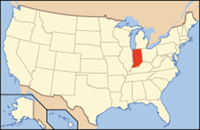
Rockhounding Indiana
Indiana is a good state for rockhounding. The state primarily is famous for limestone and coal. Southern Indiana is home to some of the most famous limestone in the world (which is a good clue that fossils also exist and that caves are likely). Indiana’s Salem Limestone (named for the city of Salem) was formed during the Mississippian Period, more than 300 million years ago. While ancient seas and geologic processes left limestone, exotic forests left coal. More bituminous coal occurs in Indiana than anywhere else in the nation, most of it in the Illinois Basin in southwestern Indiana.
State Rocks, Gemstones, Minerals, Fossils, & Dinosaurs
Rockhounding Tip: Knowing state rocks, gemstones, minerals, fossils, and dinosaurs often can be very useful information for rockhounders. Ordinarily, states with significant mineral deposits, valuable gemstones, fossils, or unusual or significant rock occurrences will designate an official state mineral, rock/stone, gemstone, fossil, or dinosaur to promote interest in the state’s natural resources, history, tourism, etc. Accordingly, such state symbols often are a valuable clue as to potential worthwhile rockhounding opportunities.
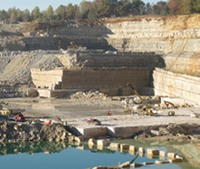
Indiana limestone quarry
State Stone: Limestone (1971)
Indiana designated Salem Limestone as
its official state stone in 1971. Limestone is a sedimentary rock made of the remains of
countless marine animals, but mostly from the shells of tiny animals. It is made of a mineral called calcium that
is used to make bones and shells.
Fossils of larger animals that sank to the seafloor after they died are
also found in limestone. During the
Silurian and Devonian periods (435 – 345 million years ago), the area now known
as Indiana was located south of the equator. Coral reefs dotted warm, shallow seas covering
northern and central Indiana. During the
Mississippian Period (360 – 320 million years ago), extensive limestone
formations developed in south central Indiana. Salem
Limestone is quarried in south central Indiana between Bloomington and Bedford and
has been used extensively for buildings for over one hundred years because of
its uniform texture and ease of working. Indiana is the world’s leading producer of
limestone and Bedford Indiana calls itself “Stone City” and the “Limestone Capital
of the World” because of its limestone quarries. Salem
Limestone was used in both the Empire State Building in New York City and the
Pentagon Building near Washington DC.
Rockhounding Resources

State-specific rockhounding books (including the books listed here as well as other books), regional rockhounding site guides, and other helpful rockhounding resources are identified - by category - in the Books & Gear section of Gator Girl Rocks with a link to the Gator Girl Rocks Amazon Store where you may easily browse selected resources and securely place an order. Your order will benefit Charity Rocks!
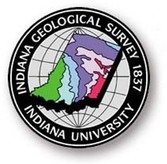
- Mark J. Camp & Graham T. Richardson, Roadside Geology of Indiana (1999).
- June Culp Zeitner, Midwest Gem, Fossil, & Mineral Trails: Great Lakes States (Rev. ed., June 1999 - first published in 1955).
- June Culp Zeitner, Midwest Gem Trails: Field Guide for the Gem Hunter, the Mineral Collector, and the Tourist (3d. Rev. ed., 1964 – originally published in 1956).
- Allan W. Eckert, Earth Treasures Vol. 1 - Northeastern Quadrant (1985; reprint in 2000).
- James Martin Monaco & Jeannette Hathway Monaco, Fee Mining & Mineral Adventures in the Eastern U.S. (2d ed. 2010).
- Kathy J. Rygle & Stephen F. Pedersen, Northeast Treasure Hunter's Gem & Mineral Guide (4th ed. 2008).
Museums of Interest to Rockhounders

Indiana State
Museum
Indianapolis,
Indiana
The museum includes permanent exhibits
pertaining to the Ice Age as well as the geologic history of the earth.
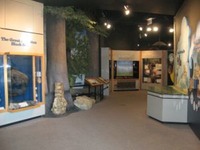
Falls of the Ohio State Park
Clarksville, Indiana
The Falls of the Ohio
Interpretive Center includes exhibits featuring Devonian
and Ice Age geology and paleontology.

Joseph Moore Museum at Earlham College
Earlham College – Richmond, Indiana
The museum exhibits invertebrate fossils from
local Ordovician limestone. In addition,
the museum’s paleontology area exhibits skeletons of a mastodon, dire wolf,
giant ground sloth, giant beaver, and an Allosaurus.
Land of Limestone Museum
Bedford, Indiana
The museum focuses on Southern Indiana’s
well-known limestone deposits.
Places to Visit - Interesting Sites To See

Falls of the Ohio State Park
Clarksville, Indiana
The Falls of the Ohio
contains over a mile of shoreline and 200 acres of unique Devonian fossil beds
when the river is low. Over the last two
centuries, scientists have described hundreds of fossil species. Although the Falls
of the Ohio is a great place to see fossils, fossil collecting is illegal
except at the designated collecting piles near the Interpretive Center, which
has Devonian fossils. There are other
localities in the area where fossil collecting is permitted.
Rockhounding Sites for Children & Families
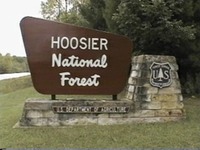
Rocks & Minerals
Hoosier National Forest – South
Central Indiana
Subject to
federal restrictions, recreational rockhounders are allowed to collect
specimens on the Hoosier National Forest.
Recreational gold panning or panning for
sapphires and garnets is allowed so long as no commercial equipment such as
dredges or sluices are used and no earth is disturbed.
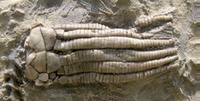
Crinoid fossil
Fossils
Southeastern Indiana
One of North America’s most famous
fossil-collecting areas is in the Ordovician (500 – 435 million years ago)
rocks of southeastern Indiana and adjacent parts of Ohio and Kentucky. These rocks are located around an enormous
uplift called the Cincinnati Dome. The
best places to search for fossils of marine invertebrates called bryozoans,
which resembled corals, are in this region. Crinoids found in Ordovician to Mississippian
formations are among Indiana’s most abundant fossils.
Fossils - Devonian
Falls of the Ohio State Park, Clarksville, Indiana
The Falls of the Ohio
Interpretive Center has a fossil collecting pile where visitors may collect fossils. Fossil collecting, however, is not otherwise
permitted.
Fossils - Upper
Ordovician
Jefferson County, Indiana
Various
fossils (brachiopods, bryozoans, cephalopods, conodonts,
corals, crinoids, edrioasteroids, gastropods, monoplacophorans, pelecypods,
scolecodont teeth, sponges & stromatoporoids, starfish, trace fossils, and
trilobites) occur in interbedded shale and limestone in the road cuts (also
creek exposures on west side) on U.S. 421 north of Madison.
Fossils - Upper
Mississippian
Crawford County, Indiana
Various
fossils (blastoids, brachiopods, bryozoans, conularids,
horn corals, crinoids, gastropods, pelecypods, shark teeth and scales, trace
fossils, trilobites) occur in sandstone, shale and limestone in road cut at
Intersection of I-64 and State Road 37 at exit 86.
Fossils - Upper
Mississippian
Crawford County, Indiana
Various
fossils (blastoids, brachiopods, bryozoans, conularids,
horn corals, crinoids, gastropods, pelecypods, shark teeth and scales, trace
fossils, trilobites) occur in sandstone, shale and limestone in road cut on
State Road 37 near Grantsburg.
Geodes
Bedford, Indiana
Geodes
containing barite, calcite, dolomite, marcasite, millerite, pyrite, quartz,
& sphalerite occur in a layer of limestone exposed by the road-cut along
State Route 37, approximately 10.5 miles north of Bedford (just south of the
Monroe Lake exit).
